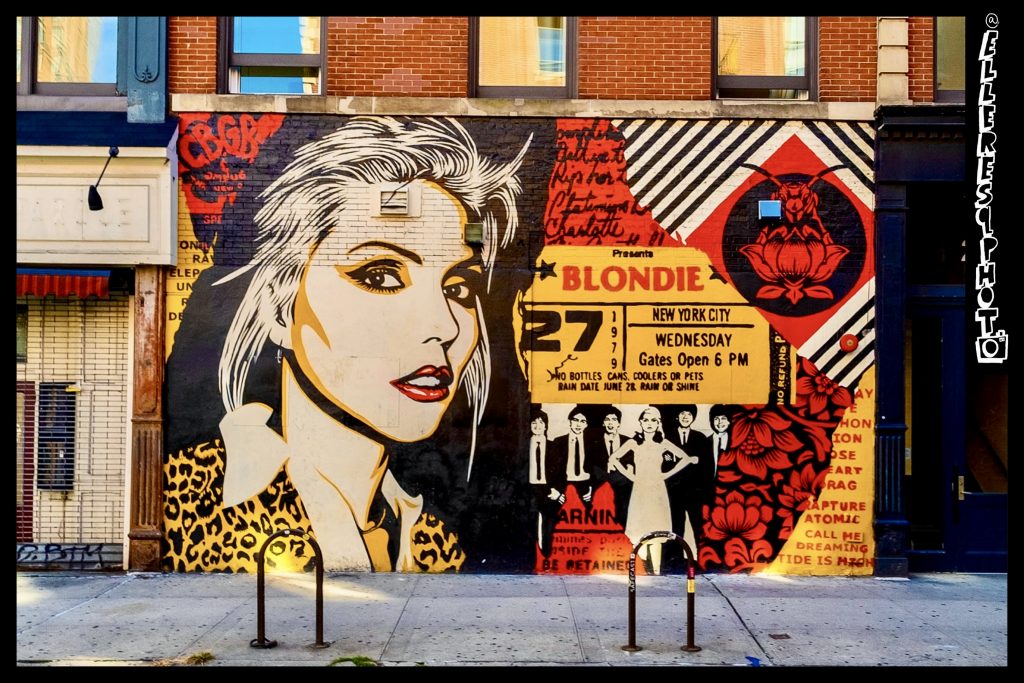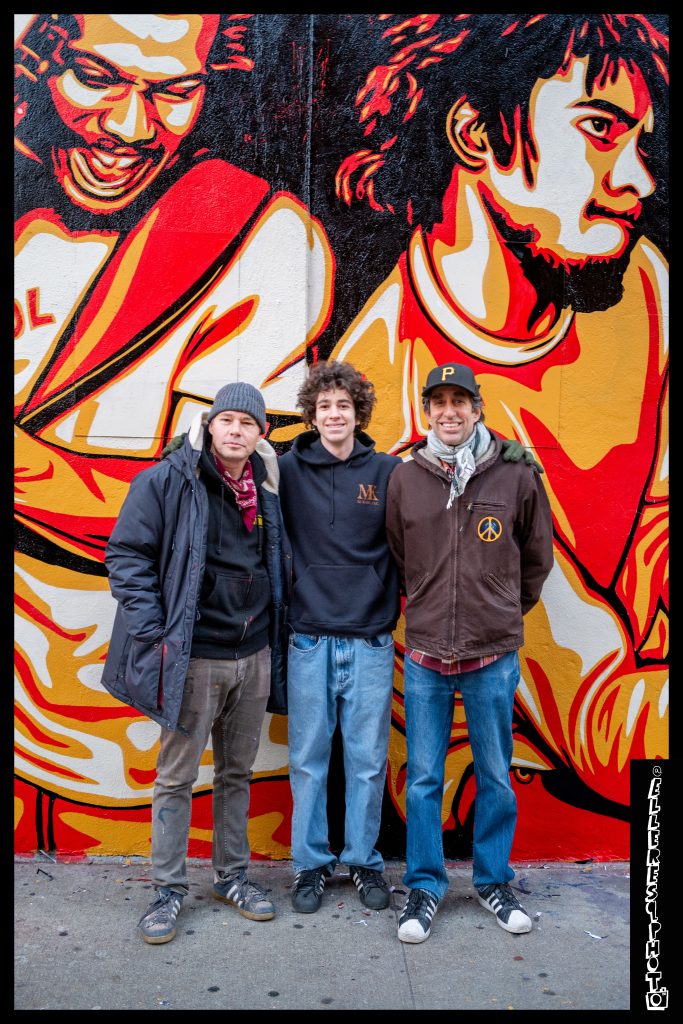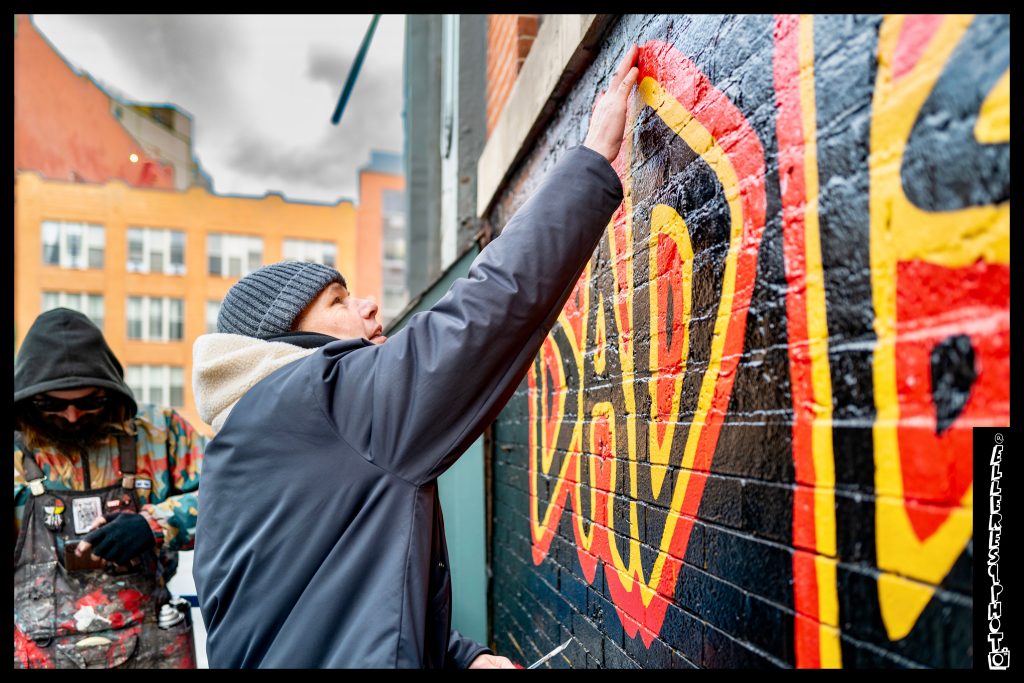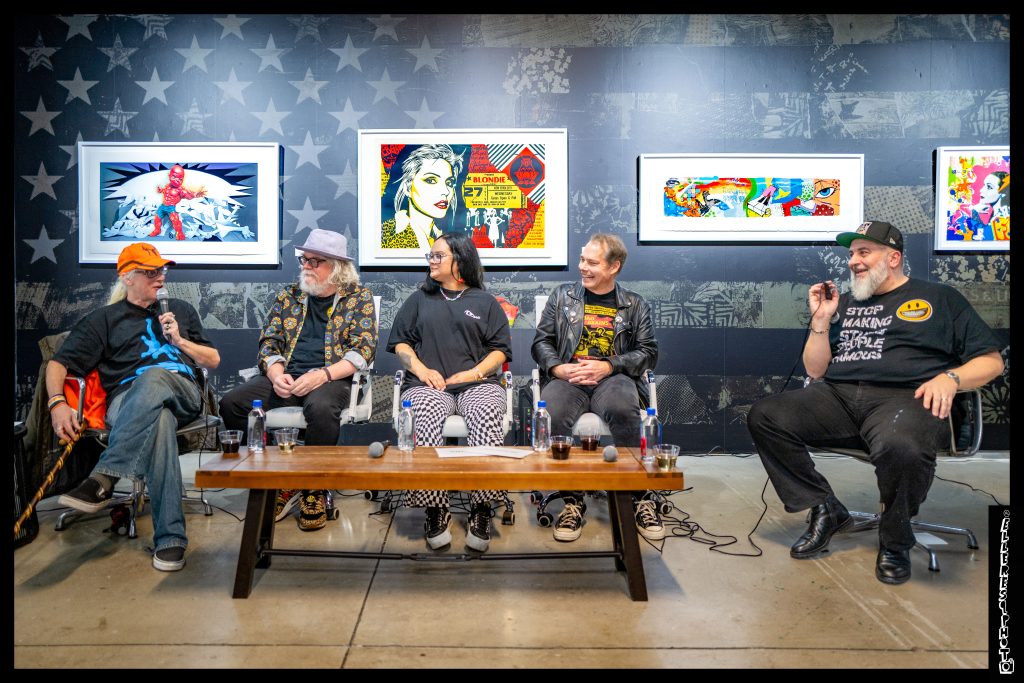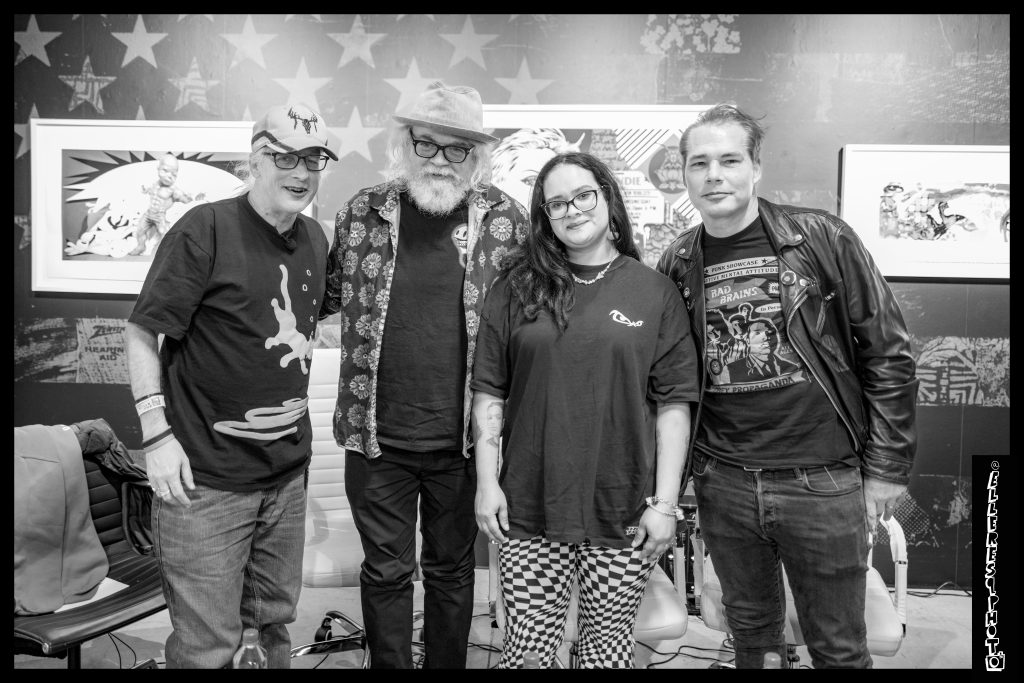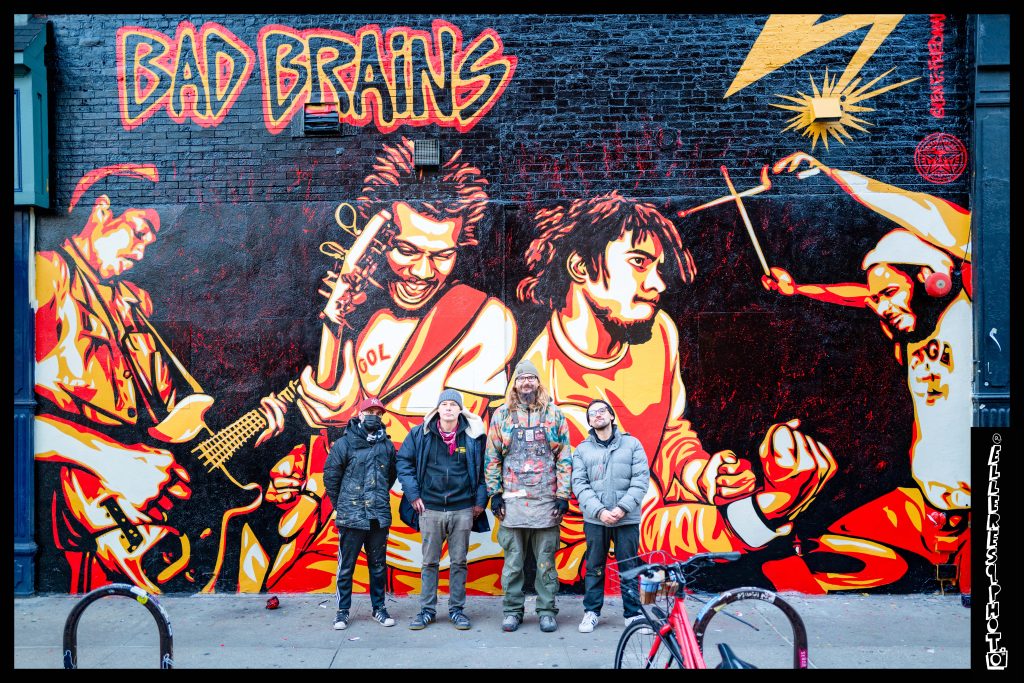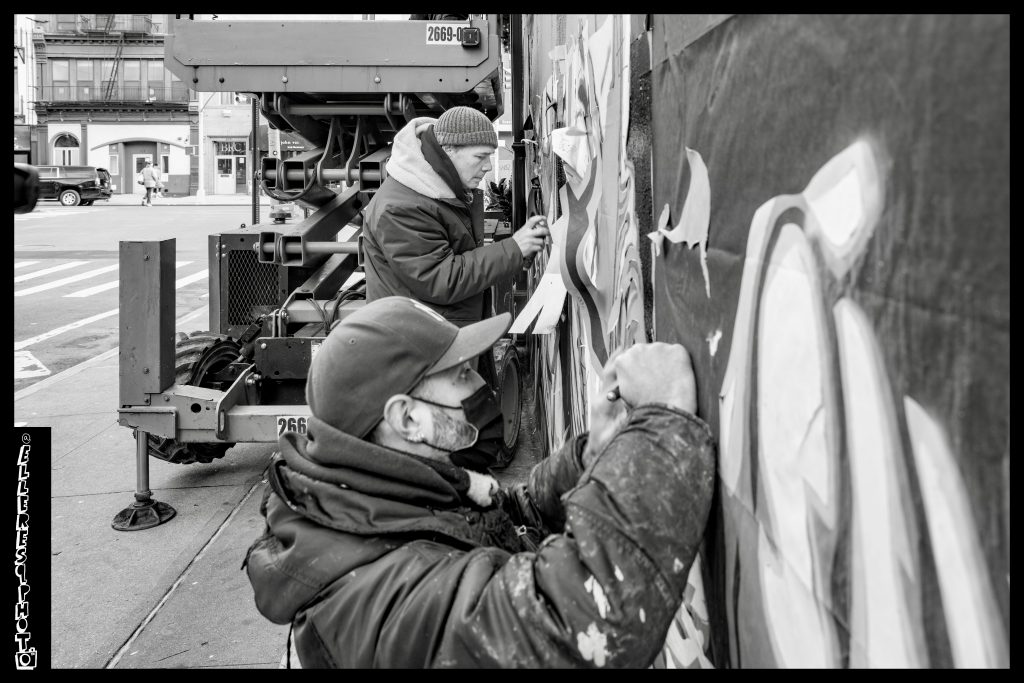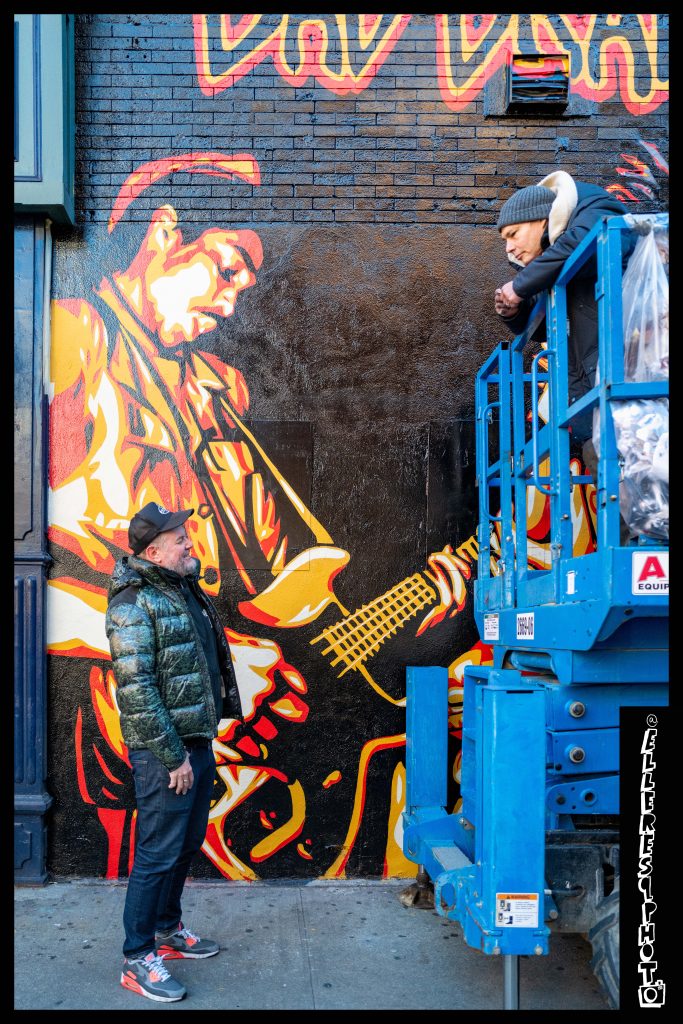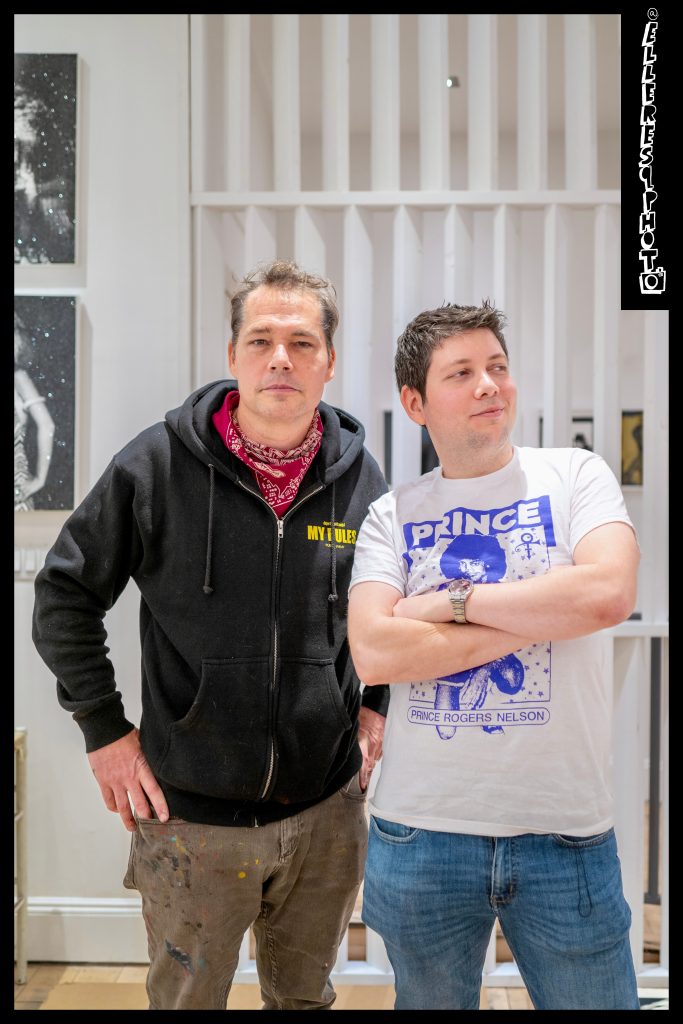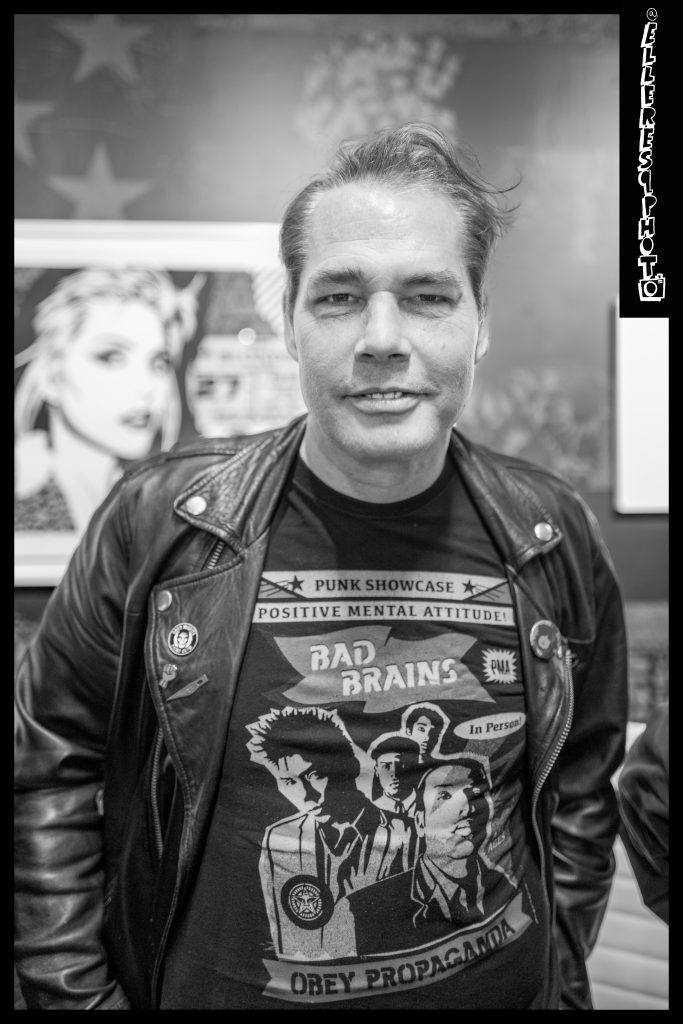 “The whole reason I got into street art in the first place was because I wanted to bring art to people rather than making people go to the art. And the fact that some people don’t like the art being brought to them gives me a lot of satisfaction.” – Shepard Fairey
“The whole reason I got into street art in the first place was because I wanted to bring art to people rather than making people go to the art. And the fact that some people don’t like the art being brought to them gives me a lot of satisfaction.” – Shepard Fairey
Matthew A. Eller: I am currently sitting with the one and only Shepherd Fairey, and a bunch of other fun people from the LISA Project & Gary Liechtenstein Editions watching Shepard sign his new screen print featuring Blondie. Since we don’t have much time let’s just quickly in a couple sentences tell anyone who does not know who you are a bit about yourself?
Shepard Fairey: I’m Shepard and I’m an artist, and an activist best known I guess for my Obey Street Art and Clothing line, and of course the “Hope” Obama poster that I made as a grassroots tool to aid the Obama’s campaign. Or maybe the, “We the People” posters that I created for the Women’s March on Washington.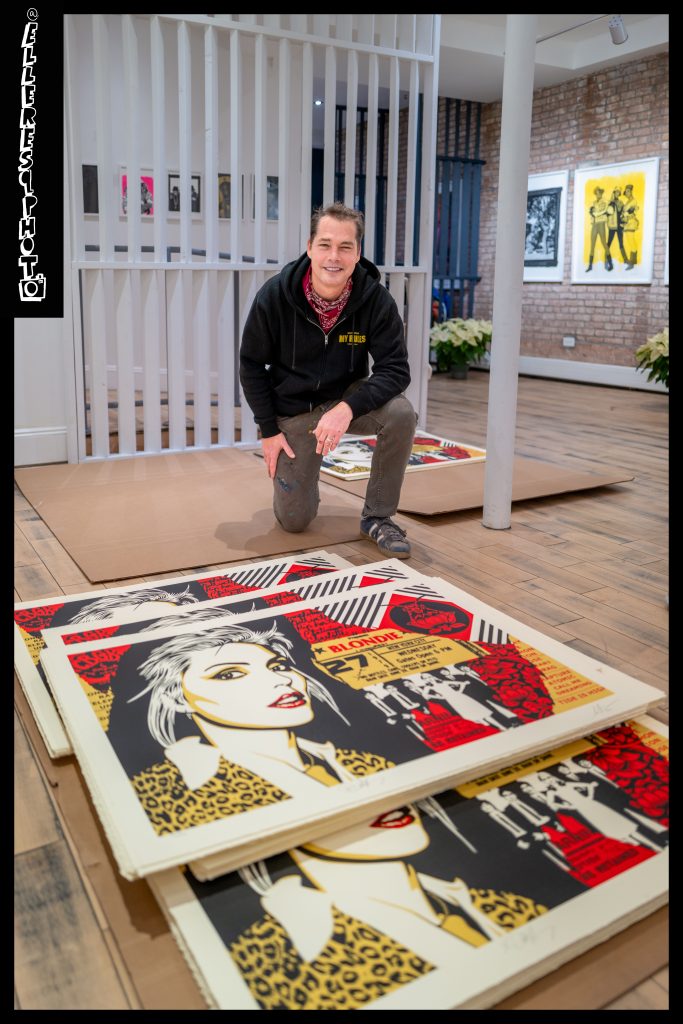 Matthew A. Eller: Perfect, and can you tell me a little about this beautiful Blondie Print you are currently signing?
Matthew A. Eller: Perfect, and can you tell me a little about this beautiful Blondie Print you are currently signing?
Shepard Fairey: Well I have worked with Lisa Project on a few different projects over the years including in 2016 painting this Blondie mural depicted in this print. So when the opportunity came up to paint this image on a wall at Bleeker and Bowery, right across from where CBGB’s used to be, I couldn’t turn it down. I absolutely loved the idea because my first solo art show in New York in 1998 was at the CBGB’s Gallery, plus I love all the music that came out of CBGB’s like The Ramones, Television, Talking Heads, Bad Brains played there a lot, and of course Blondie.
Additionally, in 2016 I worked on Blondies album package for their “Pollinator” album, and the flower and the bee at the top right corner of the mural is from that album art. I was extremely excited to do something that tied in with a band like Blondie that I loved historically, but who I had also worked with recently. So this print is based on the mural that I previously painted across from CGBG’s, which is now coming down and I’m replacing it with a new mural of the one and only Bad Brains. It’s just great that this mural is now being memorialized with this really beautiful large format screen print by Gary Liechtenstein with the proceeds helping the LISA Project fund future murals and events. And just in time because as of this morning it’s just a yellow wall. We already started on prepping for Bad Brains!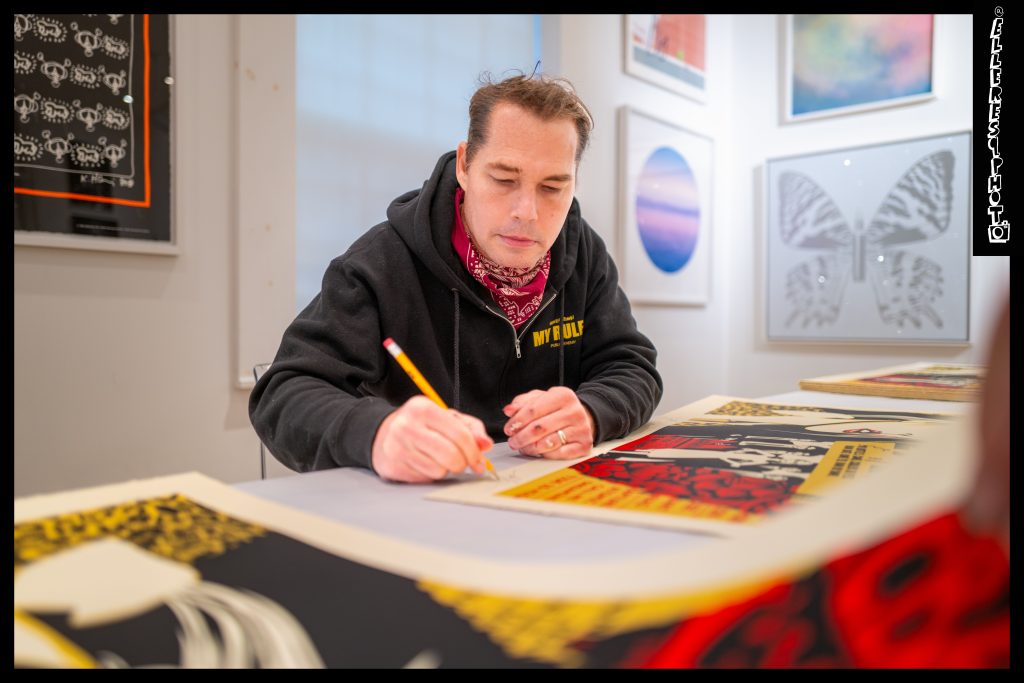
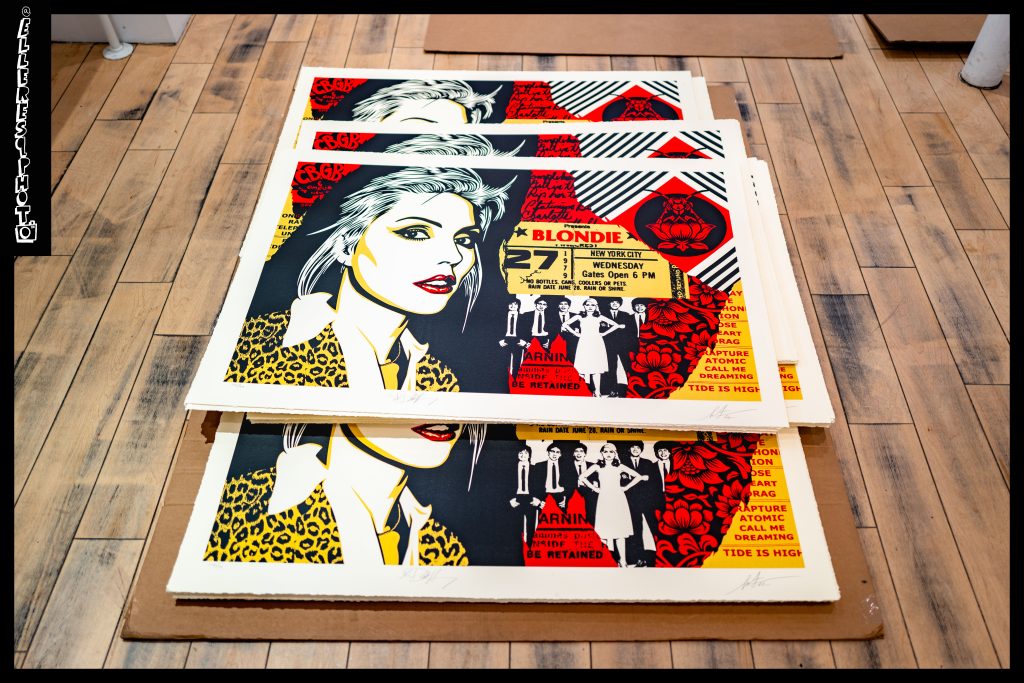 Matthew A. Eller: How is this new Bad Brains mural going to be different then the old Blondie one?
Matthew A. Eller: How is this new Bad Brains mural going to be different then the old Blondie one?
Shepard Fairey: So this Bad Brains mural is basically an update to the first Bad Brains collaboration I did in 2008. In that image three out of the four photos were based on pictures taken at CBGB’s. Only the HR image in that 2008 collaboration was photographed at the Whiskey in LA. So to keep it geographically relevant, I talked to Glenn (Friedman) and said, “You know, why don’t we re-illustrate HR? But Glenn was so partial to his shot of HR that I ended up re-illustrating two of them. So this will be something special when it’s finished that people haven’t seen exactly before, but it’s definitely reminiscent of the 2008 piece.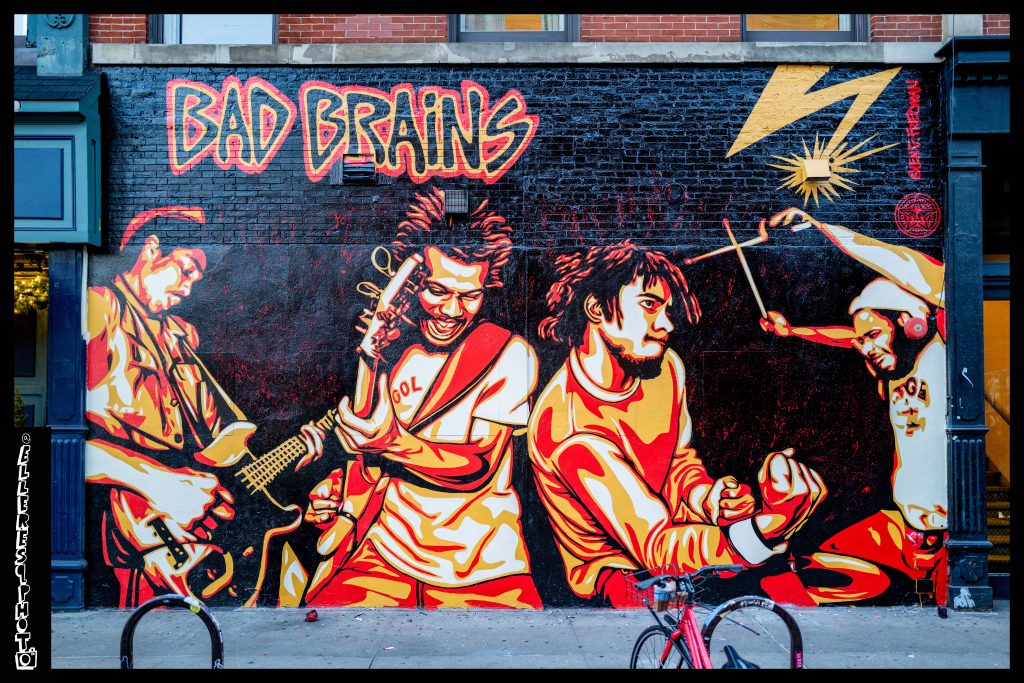 Matthew A. Eller: Were Bad Brains your first choice for the mural?
Matthew A. Eller: Were Bad Brains your first choice for the mural?
Shepard Fairey: Well, my first choice after Blondie <Laughing>, but I also love, the Talking Heads, I love Richard Hell and the Voidoids who were all in the running, but I think that having an opportunity to remind people that Bad Brains are the first all black hardcore band (honorable mention off course to A Band Called Death the first all black punk band). And even though they’re from DC originally, that first album cover with the Capital being struck by Lightning was recorded on the Lower East Side of Manhattan and they played CBGB’s all the time. So they are as important as anybody who was part of that history of the first wave of New York punk. They were a very crucial band. They heavily influenced that next wave of New York hardcore bands like the Cro-Mags, and Agnostic Front to name just a few. All of those bands were massive fans of Bad Brains. So I feel honored to get to paint a mural to represent that era.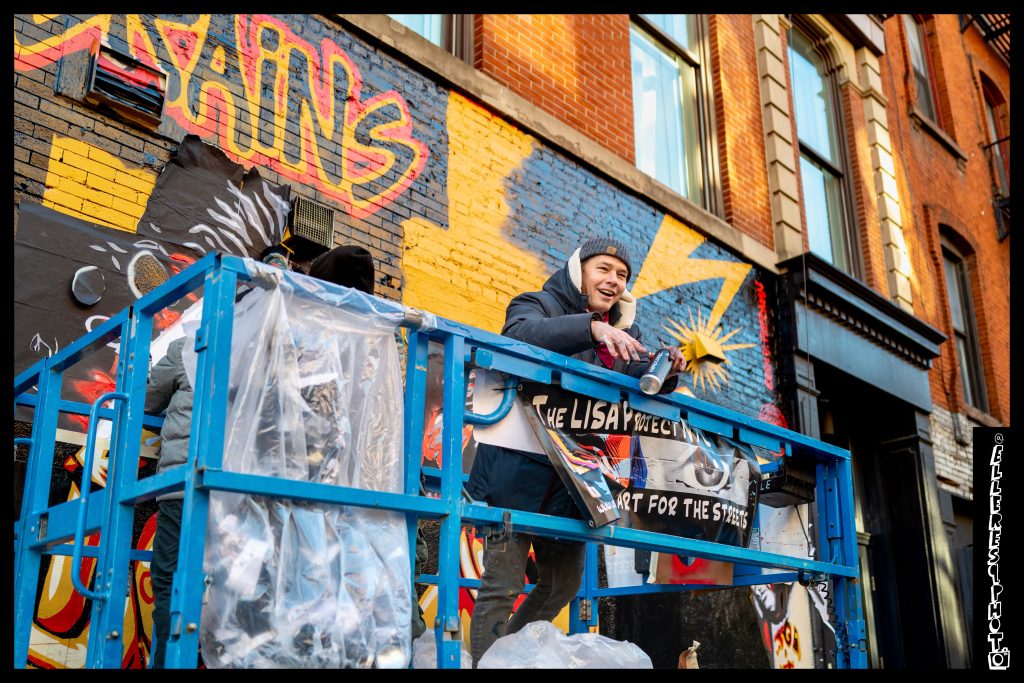
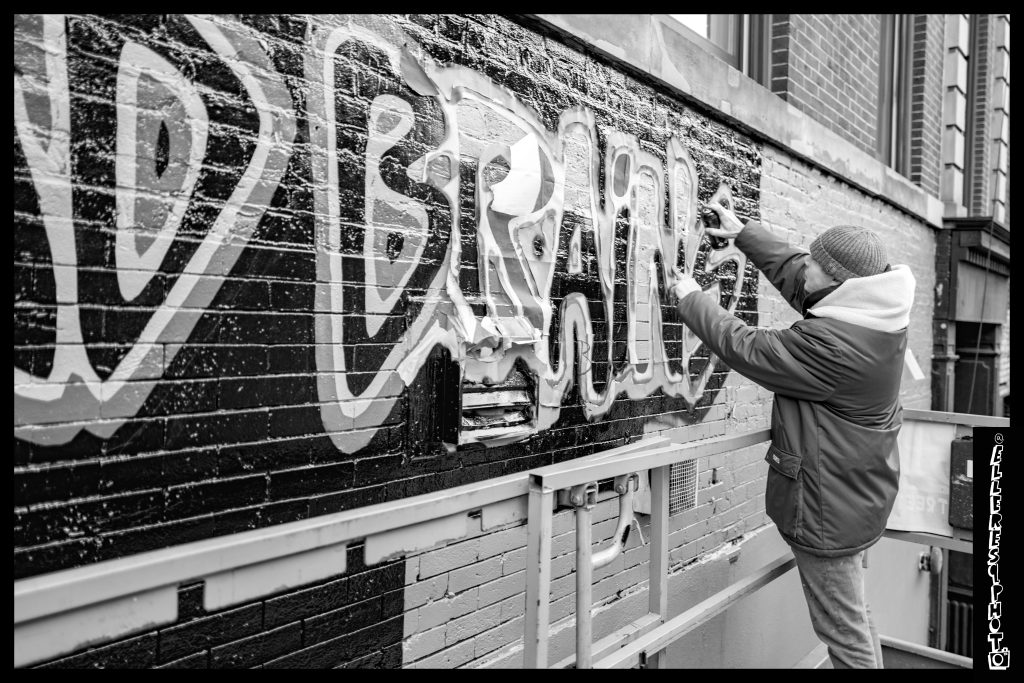 Matthew A. Eller: I know that skateboarding culture and Punk Rock has been a huge influence on your work. For this new Bad Brains mural you used Glen E. Friedman’s Bad Brains photos as we just discussed a bit, and he got his start as a photographer for Thrasher and later captured every punk band and hip-hop artist you can imagine. Can you talk a bit about this fusion of skateboarding culture and your art?
Matthew A. Eller: I know that skateboarding culture and Punk Rock has been a huge influence on your work. For this new Bad Brains mural you used Glen E. Friedman’s Bad Brains photos as we just discussed a bit, and he got his start as a photographer for Thrasher and later captured every punk band and hip-hop artist you can imagine. Can you talk a bit about this fusion of skateboarding culture and your art?
Shepard Fairey: I grew up in South Carolina and skateboarding was my gateway to creatively as well as my social life. Skateboarding was rebellious, it was creative, just like street art. Street art was re-enacting things on landscapes that weren’t supposed to be written on. But punk was just as in your face if not even more outspoken. It was political and I became very interested in it especially later when I started doing my street work, I was massively influenced to say the least. I already at this point in my life was skateboarding, making t-shirts, stickers, skate zines, and putting up flyers with glue. So I thought, well I wanna do work on the street… but I want to do it with techniques that I already have been using and refining. So pasting up posters seemed to fit the best.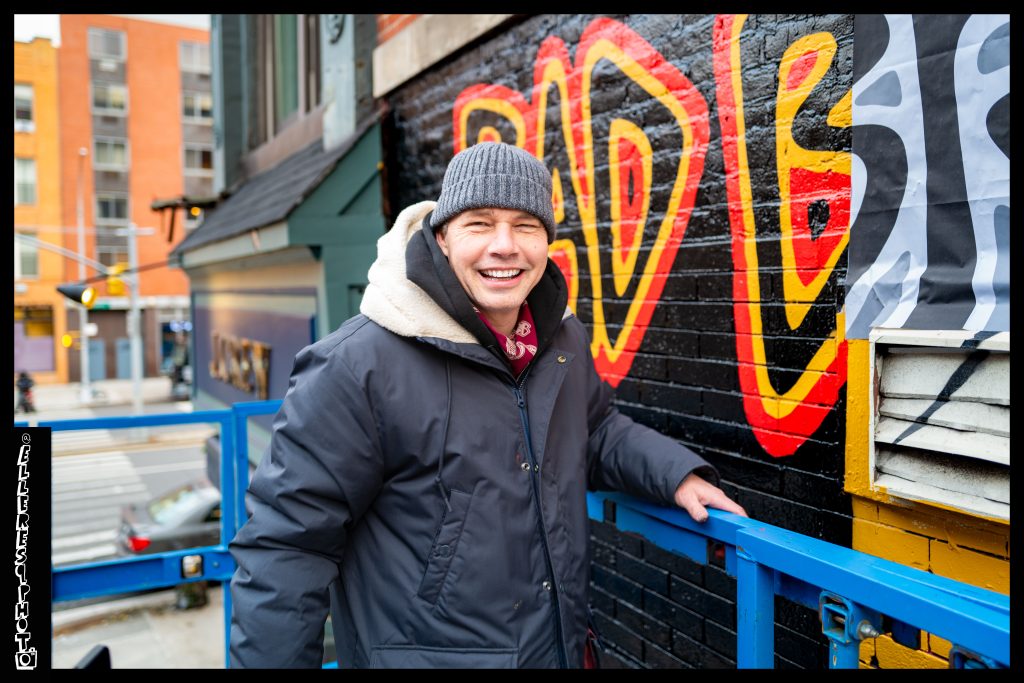
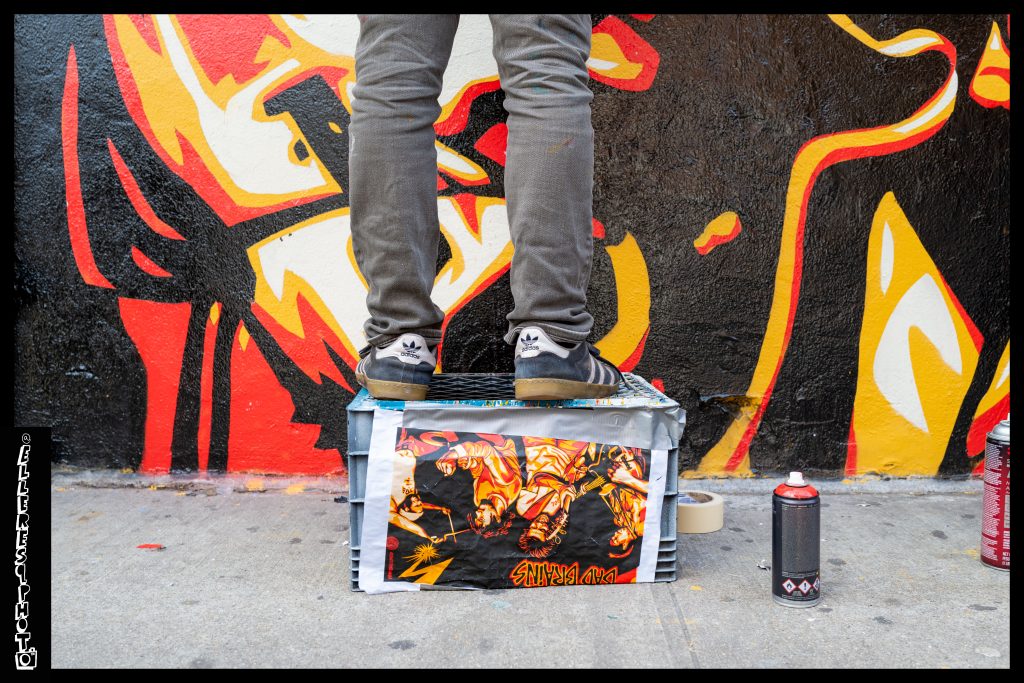 Matthew A. Eller: There also seems to be a common thread between the two because skateboarding and street art both involve objects that you need to destroy to create something new.
Matthew A. Eller: There also seems to be a common thread between the two because skateboarding and street art both involve objects that you need to destroy to create something new.
Shepard Fairey: For sure, street art, punk rock, this idea of living in the moment and being free. There’s a relationship between the creativity and the destruction that are part of a healthy symbiotic cycle. It’s a cycle, and you embrace that cycle and you keep moving and that’s absolutely part of it, and a necessity when you’re working in street art because a lot of what you do is going to disappear.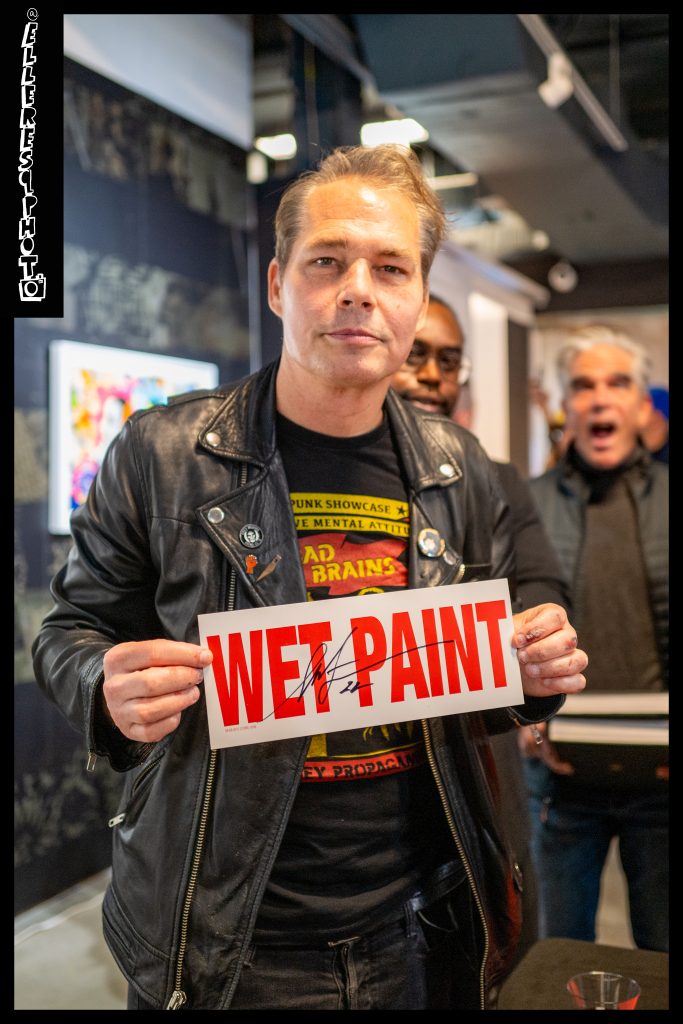 Matthew A. Eller: It’s funny because back in the day, you could go to your website and buy one of probably 8 available prints for about $50 each. Ironically, the first print I ever bought of yours was the “Obey” Bad Brains inspired Capital Building print from 2002. I’ve always appreciated the fact that you make your work available at basically any price point. You can buy high quality signed open edition prints for under $50 at all times, a sticker or button for under $20. Did this kind of just happen? Or was this always part of your “business model”?
Matthew A. Eller: It’s funny because back in the day, you could go to your website and buy one of probably 8 available prints for about $50 each. Ironically, the first print I ever bought of yours was the “Obey” Bad Brains inspired Capital Building print from 2002. I’ve always appreciated the fact that you make your work available at basically any price point. You can buy high quality signed open edition prints for under $50 at all times, a sticker or button for under $20. Did this kind of just happen? Or was this always part of your “business model”?
Shepard Fairey: Oh the one where I substituted the LA City Hall for the DC Capitol building? That’s a great one! Well I never had a “business plan” because I just didn’t think that way. Actually my business plan may have been to just survive back then <Laughing>. But the thing is when I was in my twenties, I was really broke and there were a few artists like Frank Kozik who sold stuff at a reasonable price. And the model of making screen prints that were affordable also worked well for me because I would screen print posters on thin paper and put them on the street and then screen print the same image on thicker paper to sell. So there was an efficiency there, but I always thought that my work was only going to appeal to the down and out types anyway (Laughing). But, No, you’re exactly right, I always appreciated artists like Kozik who made work that I could actually afford in my younger, poorer days. So I want to make stuff that’s accessible to the kind of people I’m friends with. And as I expanded my art operations to include original works and more expensive hand-embellished pieces, I always thought it was important to keep the accessible stuff in the mix for my fans. And yes, you can say it’s a reasonable business strategy, but a lot of galleries over the years have said to me “Well, if you just restrict the supply so we can increase the demand, you’ll make more money then you make on your prints because it will elevate your fine art sales”. That is probably true, but it does not align with my philosophy. The whole reason I got into street art in the first place was because I wanted to bring art to people rather than making people go to the art. And the fact that some people don’t like the art being brought to them gives me a lot of satisfaction.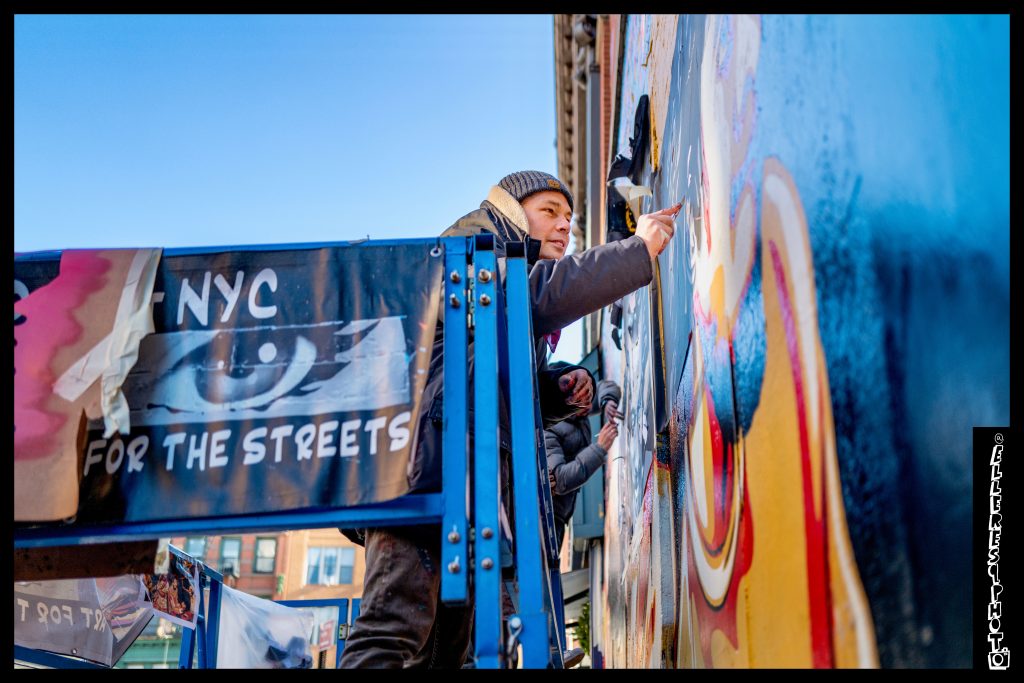
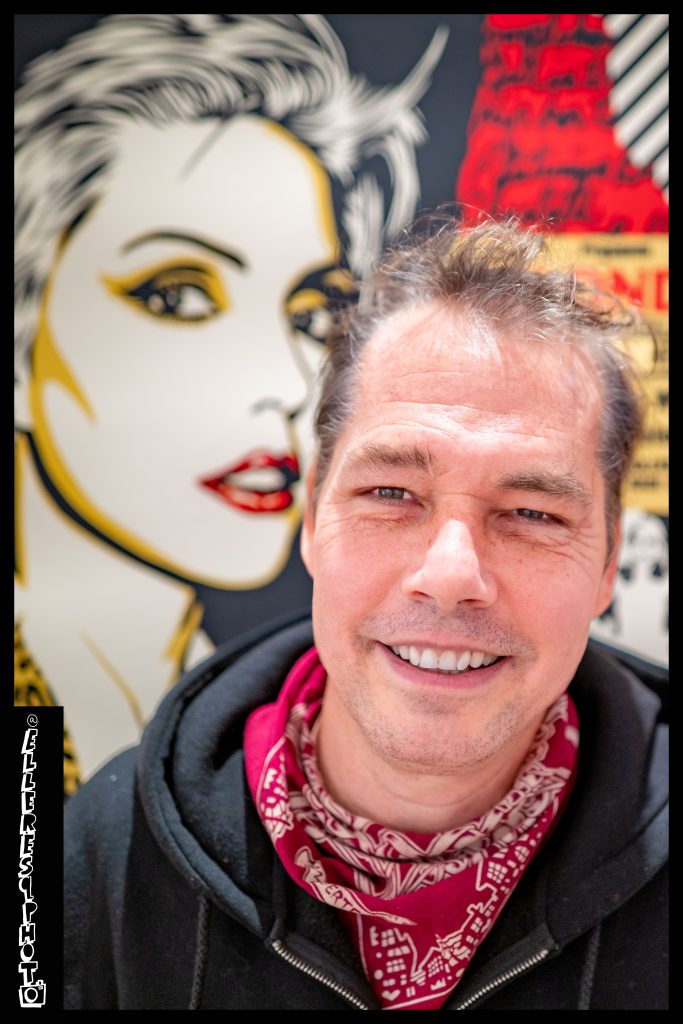 Matthew A. Eller: Well later tonight I know you are bringing the art by participating in a panel at WCC with Ron English, Indie184, Wayne from the LISA Project, and Carlo McCormick who I believe curated your first show in NYC?
Matthew A. Eller: Well later tonight I know you are bringing the art by participating in a panel at WCC with Ron English, Indie184, Wayne from the LISA Project, and Carlo McCormick who I believe curated your first show in NYC?
Shepard Fairey: Yeah! Carlo curated the very first show I was in which actually started at Bard College in 1994 and then was moved to the Electric Gallery in NYC. So I didn’t know it was gonna go to the Electric Gallery, but I got a call from Evan Bernard, which I don’t know if you know who that is, but he’s mentioned in the Beastie Boys song “Get it Together”… “drive the lane like I was Evan Bernard”!
So anyway, I got a call at my studio in Providence and it’s Evan Bernard asking “if I was going to be attending the art show that night in NYC”? I didn’t even know anything about it! He said “The show starts at seven o’clock tonight, and you’re featured in it!” And I said, “Uh, well I guess I’m gonna close the print shop early today and we’re gonna go to New York for the night!” And he said “Oh, okay, cool… Well if you do bring some of your t-shirts I’m an XL!”<laughing>. It turns out I had a friend and she was friends with Carlo and she got my stuff into his show.Matthew A. Eller: Did any sell at the first show?
Shepard Fairey: I don’t think I sold anything at that show.
Matthew A. Eller: I think you would remember selling your first piece in a gallery in NYC.
Shepard Fairey: You’re probably right (Laughing)! But there was another show at Holly Solomon Gallery in Soho around that time Carlo curated where he definitely did sell some of my pieces. I remember he was a lifesaver because I was broke and I think those pieces sold for around $400 each. My rent in Providence for my studio space was maybe $500 a month for 3,500 square feet. I even had my skateboard ramp in there with all my silkscreen stuff. But even with it being that cheap, between studio expenses and my apartment rent, and some cash to pay a few friends to help out and all that stuff… I was broke!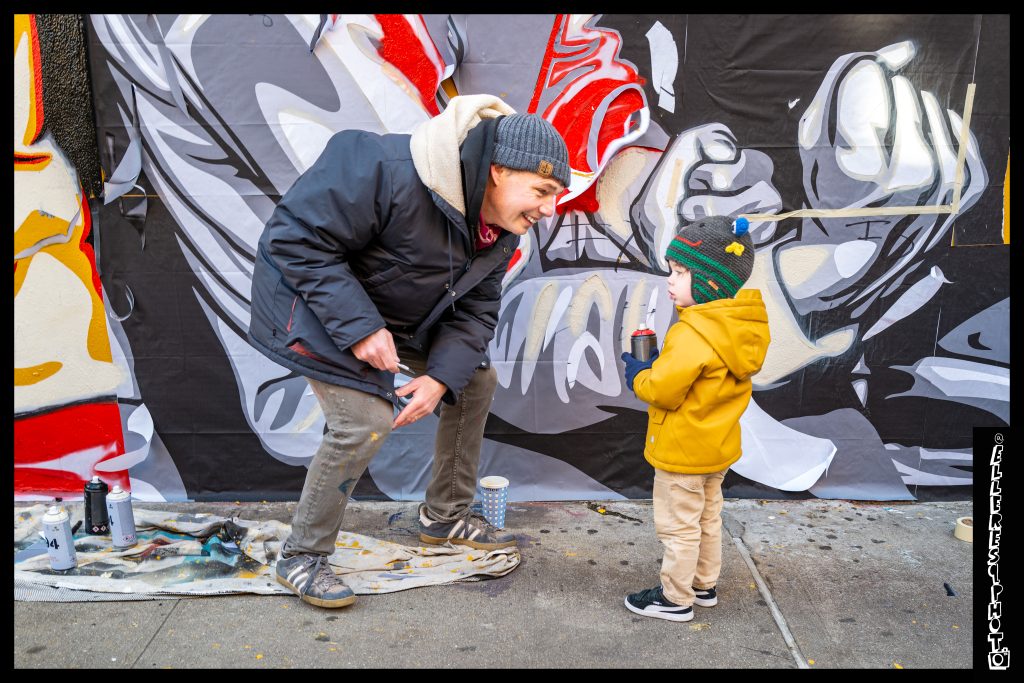 Matthew A. Eller: So those were your first 2 shows in NYC?
Matthew A. Eller: So those were your first 2 shows in NYC?
Shepard Fairey: Those were my first two shows that weren’t at a Cafe <laughing>.
Matthew A. Eller: So what year is this?
Shepard Fairey: These shows were in 1994 and 1995. So I’ve known Carlos for a long time now, over 30 years. The thing is that Carlo has impeccable taste. He’s brilliant, he’s an incredible writer, he knows everybody, and yet he’s so not career advancement oriented <laughing>. I feel like that for the number of things he’s done that are important in celebrating and helping promote one of the only culture’s that’s mattered to me, Carlo should be very well off, but it just doesn’t matter to him. I think that’s cool in one way, but also unjust in another. Other people have stepped into the fertile zone that was cultivated by Carlo and they’ve benefited far more than he ever will.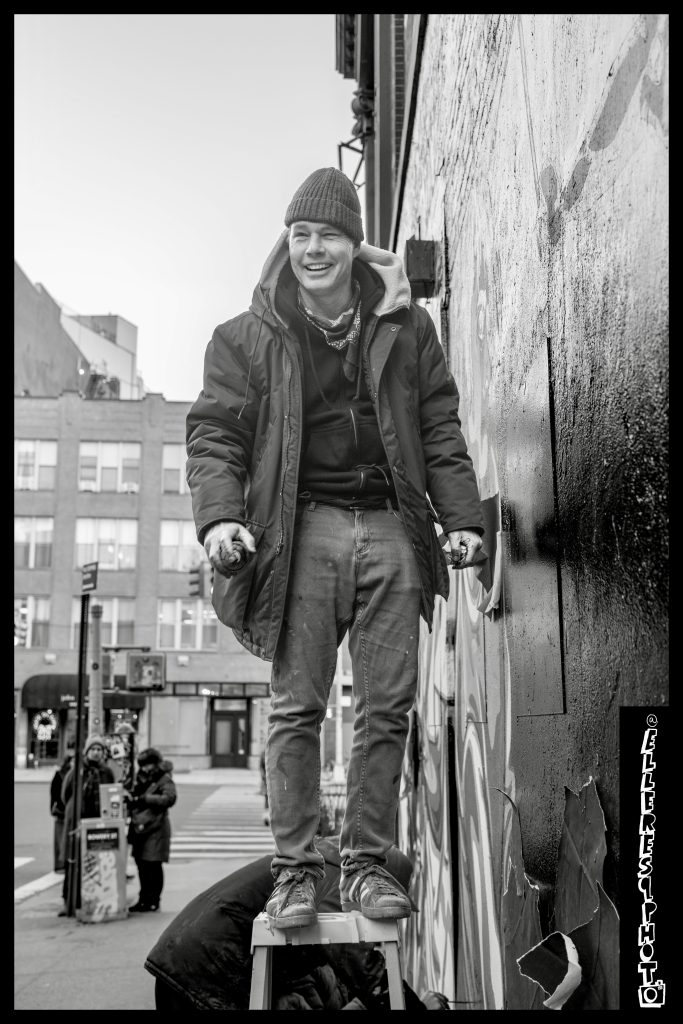
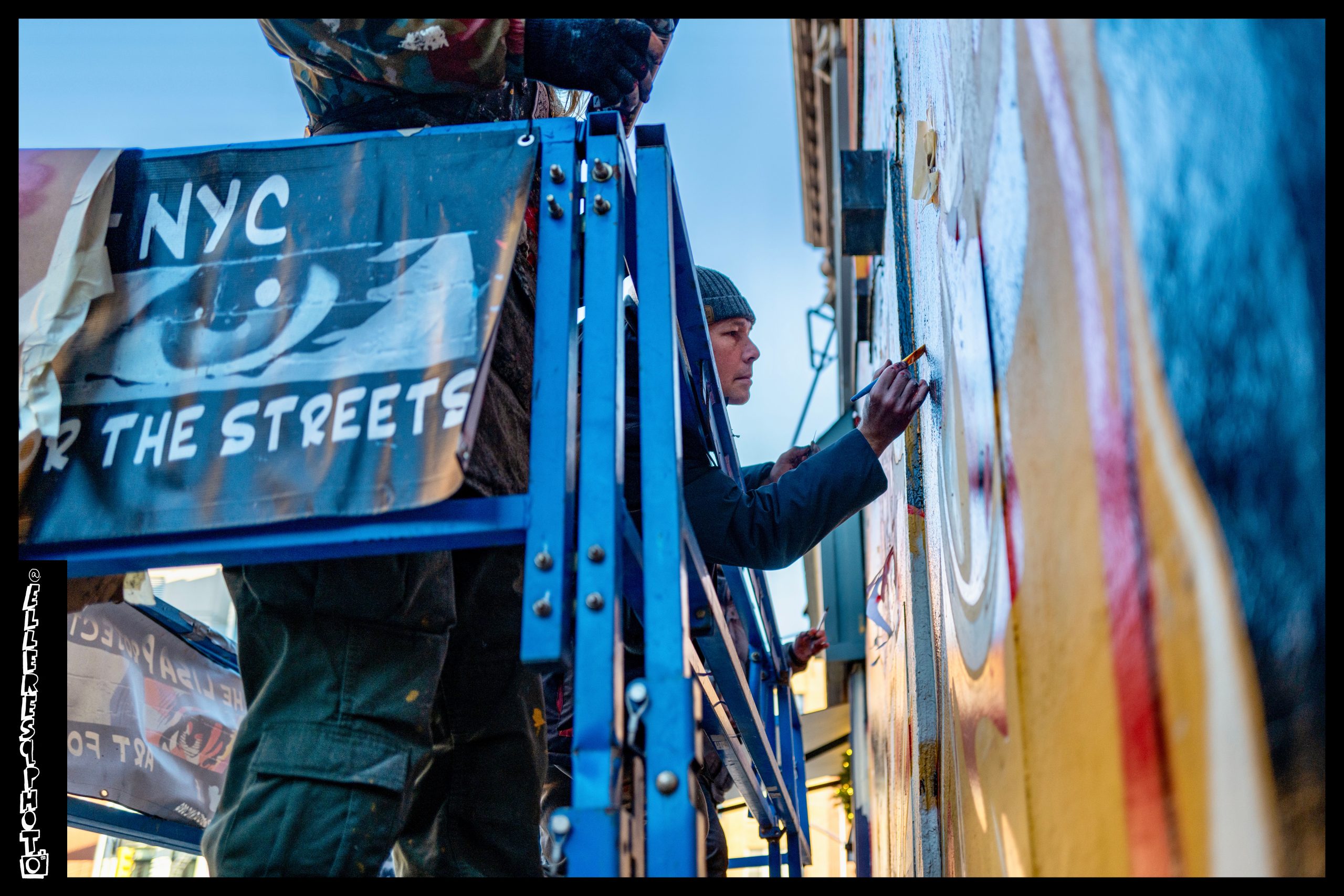
Matthew A. Eller: And he’s a character to say the least. But back to the Bad Brains and Blondie murals, and music in general, tell me about some other musical collaborations that were your absolute favorites?
Shepard Fairey: I love music and earlier on in my career I had to take work wherever I could get it to survive. So I did some stuff for bands I wasn’t a huge fan of, but for the last 15 years I really only worked with artists I wanted to work with. In particular I can’t believe I got to work with Interpol. I first worked with Interpol in 2004, and I also later painted an Interpol mural in Williamsburg, Brooklyn in 2014, and it was like 25 degrees below freezing in November, which was really unexpected. It had been warm a couple weeks before that but it was the absolute worst conditions temperature wise I think I may have ever painted in. There were a lot of bands I was hoping to work with but I never thought I would get to work with Interpol who were at the top of that list. Andy Warhol had The Velvet Underground and that was what was cool for New York then, but Interpol is what’s cool in New York now. But, it’s hard to pin down because I’ve gotten to do stuff for Black Sabbath, Henry Rollins, not to mention Bad Brains of course, Iggy Pop and the Stooges! All of these things were incredible honors! I didn’t get to work with him when he was alive but I just got to do a poster of David Bowie. That was incredible to do because I absolutely love David Bowie. I got to work from some outtake shots from the “Ziggy Stardust and the Spiders From Mars” cover. The image that I used for the Bowie poster was an awkward shot because he is holding a guitar up against a wall. So for an album cover it was weird, but his face looked amazing. So it doesn’t work that well as a photograph, but you take some liberties and make it an illustration, suddenly it’s awesome! We have somebody like David Bowie who was exceptionally photogenic, and there’s so many great images of him out there, so to find a new one that people haven’t seen before, and to be able to create something new for such an icon is not easy. But I was really happy with how it turned out.Matthew A. Eller: Let’s talk about your mural process a little bit. I noticed that you paste the photocopies of the mural design on the wall and then cut out the stencil directly on the wall itself. I’ve never seen someone create a mural in this fashion. I’m surprised more people don’t work like this. It’s very efficient I’m assuming?
I didn’t get to work with him when he was alive but I just got to do a poster of David Bowie. That was incredible to do because I absolutely love David Bowie. I got to work from some outtake shots from the “Ziggy Stardust and the Spiders From Mars” cover. The image that I used for the Bowie poster was an awkward shot because he is holding a guitar up against a wall. So for an album cover it was weird, but his face looked amazing. So it doesn’t work that well as a photograph, but you take some liberties and make it an illustration, suddenly it’s awesome! We have somebody like David Bowie who was exceptionally photogenic, and there’s so many great images of him out there, so to find a new one that people haven’t seen before, and to be able to create something new for such an icon is not easy. But I was really happy with how it turned out.Matthew A. Eller: Let’s talk about your mural process a little bit. I noticed that you paste the photocopies of the mural design on the wall and then cut out the stencil directly on the wall itself. I’ve never seen someone create a mural in this fashion. I’m surprised more people don’t work like this. It’s very efficient I’m assuming?
Shepard Fairey: There are a few people who do it this way actually. Cleon Peterson does it this way, Francisco Reyes, Jr. (Never Made) he does it this way as well. They both actually have worked with me and that’s how they were exposed to this method. A lot of people that have learned how to do big murals that are in my orbit saw this technique and they like it! It’s like “oh yeah, that works because you’ll get all your proportions just right”. Some people use a projector, but it’s often hard to get the right spot for the projection to fit the wall. Sometimes it’s hard to get a good projection at night because there might be too much light to see what you’re projecting.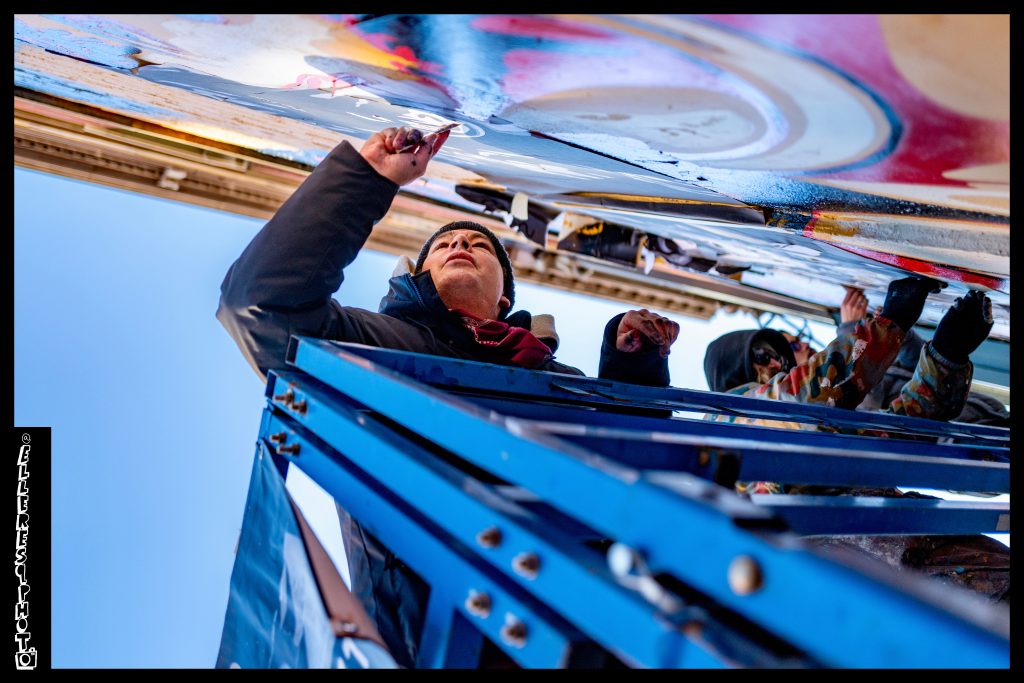
 Matthew A. Eller: I guess it’s much cheaper to print these out than having stencils cut? And much easier to carry backup pieces or reprint them in a pinch?
Matthew A. Eller: I guess it’s much cheaper to print these out than having stencils cut? And much easier to carry backup pieces or reprint them in a pinch?
Shepard Fairey: Exactly. Mess one up, you can get another one printed at any copy shop, It’s not a big deal. Every now and then I’ll laser cut some really intricate elements so that it doesn’t have to be cut on the wall, but most of it’s just cut by hand right on the wall. When I first started doing murals I tried pre-cutting big stencils but it’s actually harder to use them because the way the wind catches the stencil and the way they get really fragile when they’re pre-cut can be a big issue. Plus, sometimes it’s hard to get it positioned properly for instance if it’s an uneven wall, with these non-cut more malleable paper pieces I can paste them over obstacles like this pipe way more evenly.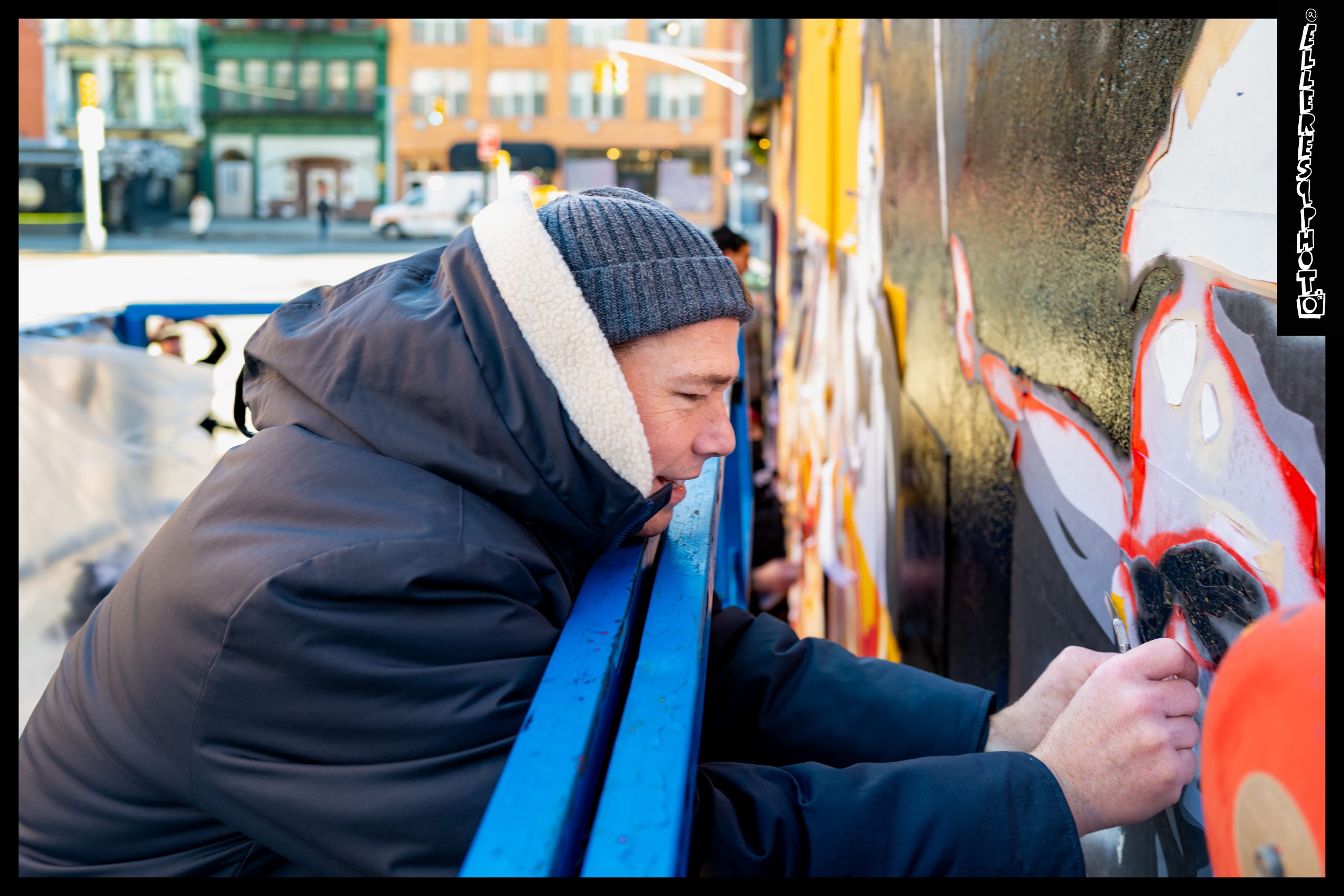
Matthew A. Eller: So we have to get going to the panel discussion but one last question, Who is an artist that you have really enjoy working with over the years?
Shepard Fairey: Space Invader in particular is really awesome. He’s just an awesome guy and he’s so obsessive and hardworking. I don’t think there’s anybody who has gotten up more than him. Plus, he’s using a medium that’s not easy to apply. He’s put up thousands and thousands of those tiles, and that’s always really impressed me. Additionally, Space Invader keeps his identity a secret so he can be out and about and no one knows he’s there, which always makes it an adventure to work with him. I always really have a real blast with him, we even ended up doing a t-shirt collaboration together years back. I hope to enjoy more adventures with him in the near future!
Matthew A. Eller: Shepard thank you for your time and can’t wait to see what you paint next! 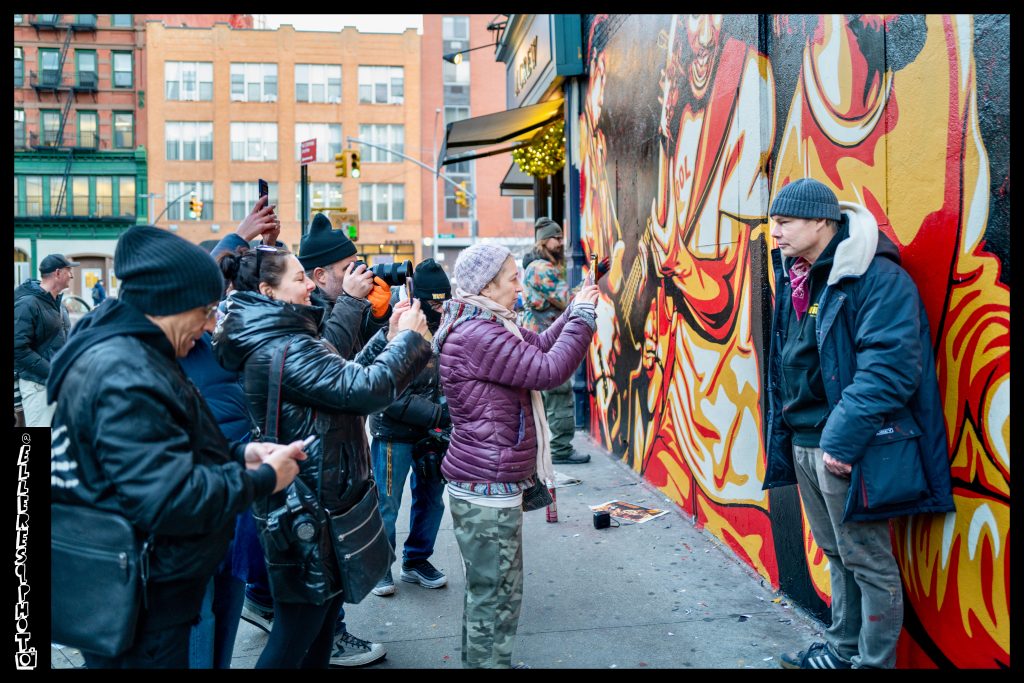 The Lisa Project 10 Year Anniversary Collection (featuring Shepard Fairey, Ron English, Crash & Daze, & Indie184) is available for purchase HERE right now! Additionally add @elleresqphoto on instagram to find out the details of a signed Shepard Fairy photo giveaway!!
The Lisa Project 10 Year Anniversary Collection (featuring Shepard Fairey, Ron English, Crash & Daze, & Indie184) is available for purchase HERE right now! Additionally add @elleresqphoto on instagram to find out the details of a signed Shepard Fairy photo giveaway!!
All Photo’s & Text Copyright 2023 Matthew A. Eller. Follow me on Instagram @elleresqphoto. #elleresqphoto #elleresqphotowall

